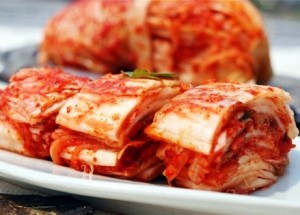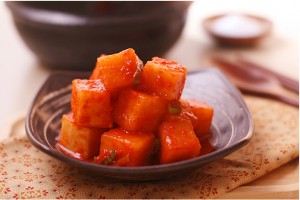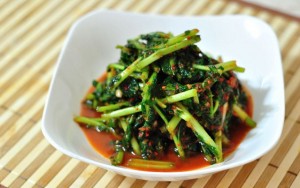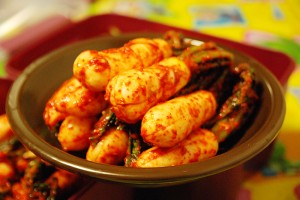WRITTEN BY: Lorraine Murray
Kimchi is the iconic dish of Korean cuisine and has been gaining popularity worldwide in the past decade or so for its health benefits and its just plain deliciousness. Most people who are new to Korean food think of kimchi as the red, spicy, garlic-laden fermented cabbage dish that usually accompanies the main courses in Korean restaurant meals or that is served in kimchi jjigae (stew), kimchi pancakes, and kimchi fried rice. Actually, though, baechu (napa, or Chinese, cabbage) kimchi is only one of an estimated 200 existing types of the traditional side dish. Kimchi can be made with many different kinds of vegetables and can also include fish or meat. Some kinds don’t even have pepper flakes (gochugaru) as an ingredient. All, however, are fermented, complex in flavor, healthy, and quintessentially Korean. Here are 10 of the most interesting kinds of kimchi.
Baechu/Baechoo Kimchi (Napa Cabbage)
Common know Kimchi that This is the one that you can just refer to as “kimchi” and everyone will know what you mean. It’s made of salted and rinsed cabbages whose leaves have been packed and coated with a mixture of hot red pepper flakes, onion, garlic, ginger, green onions, and optional fish sauce, shrimp, or oysters (or soy sauce, for vegetarians) and Asian chives. It’s then put into a container to ferment during storage and can be kept for months or even longer (in the fridge, if you don’t have the traditional backyard to bury it in during the winter). Everyone has their favorite stage of baechu kimchi fermentation; it can be eaten fresh and is juicy and delicious when newly made, but, as it ages, it becomes more sour and better fermented.
BAEK (WHITE) KIMCHI
If baechu kimchi is the spicy devil on your shoulder, urging you on to culinary thrills, white kimchi is the angel sitting on your other shoulder. It’s made by a similar process but uses milder ingredients—no hot pepper flakes. It is just as flavorful and versatile in its own way, getting its taste from a mix of garlic, chives, radishes, chestnuts, and fruit—such as Korean pear and jujubes (the fruit, not the movie candy!)—and it’s stored and served in a fruit-tinged brine.
KKAKDUGI (CUBED RADISH KIMCHI)
Back to the song of fire and spice. Kkakdugi is made of cubed Korean radish (mu)—the large bulbous kind, white with one green end, found in Asian grocery stores. Some recipes will say that you can substitute daikon if you can’t find mu. Don’t fall for it! The two kinds of radish are related but are not the same. Kkakdugi is prepared with about the same ingredients and in the same way as baechu kimchi, but it’s especially juicy and crunchy. It goes great with almost anything, but it is a traditional accompaniment to seolleongtang, a milky-white soup made from ox bones and brisket.
PONYTAIL RADISH (CHONGGAK) KIMCHI
This cutely named kimchi is made from chonggak, a smallish white radish that comes with a long “ponytail” of greens, which is left on and eaten together with the root. This radish is less often, though more precisely, called “bachelor radish” (chonggak means “bachelor”) because its tail reminded people of the traditional hairstyle that young unmarried men in Korea once wore. It’s made with the by-now-familiar mix of hot pepper flakes, ginger, garlic, and green onion.
OI SOBAGI (CUCUMBER KIMCHI)
If you’ve always loved pickled cucumbers and for some reason dreamed of the day when science would invent a stuffed pickle, dream no more. Oi sobagi (“stuffed cucumber”) is a refreshing, crisp, and spicy variation on the general kimchi theme. Small Kirby (pickling) or Korean cucumbers are sliced in quarters lengthwise, keeping one end intact, and the resulting pocket is stuffed with finely chopped vegetables like carrot, onion, sometimes radish, ginger, and garlic. It’s good for summer and not meant to be stored for a long time—just a few days. It goes well with soups and stews.
NABAK (RED WATER) KIMCHI
One of the freshest and prettiest types of kimchi in town looks something like a pink-tinged vegetable soup or punch. Nabak kimchi, often called mul (water) kimchi, is only minimally spicy. It’s made from radish sliced delicately into small thin squares, thinly sliced carrots, green onion, and Chinese cabbage (baechu) and fermented in a brine made from the juice of Korean pear, garlic, onion, and ginger with a bit of hot pepper for color and a little bite. It is ready to eat in a few days and keeps only a week or two. Its light flavor means it goes well with oily and grilled foods.
DONGCHIMI (RADISH WATER KIMCHI)
Speaking of watery kimchi, let’s talk dongchimi (“winter kimchi”; dongchi is a Korean term for the winter solstice). It’s like a food and a beverage all in one. Smallish roundish radishes, or regular mu cut up small, are salted and combined with lots of water, some peppers, garlic, ginger, and chunks of Korean pear. Store it in a big covered jar, and, when it ferments, it makes a fizzy sweet-sour liquid you can drink alone or while you eat the vegetables. You can also use dongchimi as the foundation for a dish of cold noodles (dongchimi guksu) or rice in broth.
GAT (MUSTARD LEAF) KIMCHI
Here’s something a little different: kimchi made from dark green Korean mustard (gat) leaves and stems. Gat (Brassica juncea)—not to be confused with khat, a plant of East African origins whose leaves are chewed as a stimulant in the Horn of Africa and the Middle East—is a nutritious plant popular in Korea and parts of China. The leaves, which taste sharp and pungent, are mixed with pickled anchovy sauce, red pepper, garlic, onion, and ginger, giving it a strong and distinctive flavor.
BOSSAM (WRAPPED) KIMCHI
The word bossam in Korean indicates something wrapped and is also the name of a popular Korean meal: boiled pork belly and accompaniments wrapped together in lettuce leaves. Bossam (or, sometimes, ssam) kimchi, however, is a lollapalooza of a dish. A very special preparation that came originally from Gaeseong (now in North Korea) and was often served to Korea’s royalty during the Goryeo dynasty (935 to 1392), it contains fish, jujubes, oysters or shrimp, mushrooms, chestnuts, pine nuts, mustard leaf, radish, pear, green onion, watercress…all wrapped in whole wilted cabbage leaves and rolled up into a ball. It’s left to ferment for three to four days and is then ready to serve, but, like most kimchis, it keeps much longer than that.
KOREAN BUDDHIST-STYLE BAECHU KIMCHI
After the luxurious overkill of the bossam kimchi, let’s think light, fresh, and pure. Korean Buddhist cuisine, or temple food, is gaining in popularity in Korea and around the world because of its delicacy and healthfulness. In keeping with Buddhist principles, besides being almost completely vegan, temple cuisine omits five vegetables, the osinchae (“wrong [prohibited] vegetables”)—garlic, leeks, green onions, other kinds of onions, and chives—that are said to arouse anger and sexual desire, unwelcome distractions in temple life. But, whoops! As you’ll have noticed, those ingredients are practically synonymous with kimchi, and kimchi is practically synonymous with Korean food. So what are Korean monastics to do, not eat kimchi? Never! Korean temple kimchi is made without the osinchae but uses plenty of red pepper. Also contributing flavor are doenjang (fermented soybean paste) or soy sauce, radish, ginger, persimmon, mushrooms, and mustard greens.
Above source: https://www.britannica.com/list/beyond-the-cabbage-10-types-of-kimchi
- Baechu-kimchi, made with Napa cabbage, is a spicy pickled cabbage dish and is the most popular of the kimchi varieties, which is made from whole, salted cabbage leaves,
- Kkakdugi-kimchi, or daikon-kimchi, is a spicy cubed radish dish, similar in spices to baechu-kimchi and the use of fermented shrimp emits a darker color and strong scent.
- Suk kkakdugi, cubed daikon kimchi after parboiled daikon
- Nabak-kimchi, also known as water kimchi, is less spicy and is a soupy side dish that consists of cabbage and radish.
- Oisobagi, is a cucumber kimchi, that can be stuffed with seafood and chili paste, and is a popular choice during the spring and summer seasons.
- Yeolmu-kimchi is also a popular choice during the spring and summer, and is made with young summer radishes, and does not necessarily have to be fermented.
- Bo-kimchi is best made fresh before a meal and are made with cabbage leaves wrapped around a blend of other inner ingredients such as seafood or fruit.
- Pa-kimchi is a hot and spicy dish made with medium sized green onions.
- Dongchimi is a light and non-spicy watery radish dish.
- Chonggak-kimchi is a spicy ponytail radish kimchi dish that is one of the most popular kimchi versions.
- Yongpyon gimjang kimchi (Yongbyon style kimchi)
- Gaji kimchi, pickled eggplant
- Gat kimchi, made with Indian mustard
- Baek kimchi (white kimchi), kimchi without chili pepper
- Bossam kimchi, wrapped kimchi
Mul kimchi (water kimchi)
- Dongchimi,
- Jang kimchi, water kimchi seasoned with soy sauce
7 Kinds of Kimchi
Everyone knows kimchi. Spicy, pickled and made of cabbage. Or is it? These generalizations may be true of Napa cabbage kimchi, the most popular kind, but there’s much more variation than you might think. We’ve combed through the kimchi catalogue to find seven less common, but still highly delicious, varieties. Next time you see a UFO (Unidentified Fermented Object), pull out this article to see what it is.
different kinds of kimchi
White Kimchi 백김치 Baekkimchi
This is the kimchi that proves wrong the assumption that they’re all red and spicy. As baekkimchi doesn’t use a single red pepper flake, it’s palatable for kids, the elderly, patients with stomach problems, and even grouchy foreign barbarians. While baekkimchi may be the wallflower at the kimchi party, it’s chock full of vitamins and is good for taking down a stubborn cold.
Green Onion Kimchi 파김치 Pa Kimchi
Long, slender green onions (not the bulbous yellow variety) are the basis for this kimchi variant, most frequently prepared down south in Jeolla and Gyeongsang. Aside from the great taste, the green onions here can rid fish of toxins, aid stomach function, and restore energy. Snack on this one with a bowl of makgeolli.
Geotjeori 겉절이
While the majority of kimchi is left to rot, er, ferment for months and possibly years, geotjeori is a notable exception as it can be eaten right away. It’s briefly dipped in salt and sometimes drizzled with soy sauce instead. Diners who prefer a milder, fresher kimchi will enjoy this unfermented but still flavorful dish.
Radish Cube Kimchi 깎두기 Kkakdugi
Unlike its tamer cousin danmuji (단무지, pickled yellow radish), kkakdugi is one radical radish. It’s prepared by cubing a radish and then pickling it with the standard combination of kimchi preservatives. If you find kkakdugi tough to snag with chopsticks, just use a spoon. It’s sharp flavor makes it a great pairing with comparatively bland dishes like seolleongtang (설럴탕) and kalguksu (칼국수).
Young Radish Kimchi 열무김치 Yeolmukimchi
The radishes used in yeolmukimchi are much smaller than those that go into other kimchi dishes, which puts the focus on the stem rather than the vegetable itself. The radishes are dunked into a flour porridge with red pepper flakes, garlic, and other ingredients and then put in the fridge to pickle. The chilled but spicy broth is a favorite in the summer months.
Nabak Kimchi 나박김치
Nabak kimchi gets its name from the Korean expression nabaknabak (나박나박), which means dicing up vegetables very fine. This refers to the radish and Chinese cabbage which are cut into thin squares and soaked in a water bath with a bit of chili powder thrown in to spice things up. This one is generally eaten in the spring and summer, whereas a similarly soupy kimchi called dongchimi (동치미) is served up in the winter, minus the spice.
Chive Kimchi 부추김치 Buchu Kimchi
Chives go into this classic Gyeongsang Province kimchi. Unlike other varieties, buchu kimchi should be eaten before it gets sour, as too much fermentation will ruin the flavor. Since it’s easy to make, this is a good choice for budding kimchi cooks to start out with.
~~~~~~~~~~~~~~~~~~~~~
Types of Kimchi
As mentioned before, there are about 200 listed varieties of Kimchis in Korea. We won’t touch on them all, but we will dig into 5 of the main types of Kimchis that is usually served in most restaurants. Kimchi is usually categorized into two different categories – seasonal andwinter Kimchi. Try and familiarize yourself with these different types of Kimchis and the next time you make a pit stop in a Korean restaurant, try and quiz yourself on asking yourself what type of Kimchi it might be.
“Whole Cabbage Kimchi”
This is the most popular Kimchi out of all on the list. It is typically served with almost all meals from breakfast, lunch, and dinner. This Kimchi is usually never spicy but rather mild. Whole crowns of cabbage are sliced off to abstract any discolored outer leaves and then divided perpendicular into four sections. These four sections are then soaked in salt for about three or four hours until they have eased and softened. While this process of softening is going on, the other ingredients are then assembled and mixed together such as pepper powder, chopped garlic, ginger, and other pickled seafood such as fish. When both the ingredients and the cabbages softening process is finished, they are ready for mixing. Once the process of mixing is finished, the baechu Kimchi is then cut in to bite size pieces and mixed again.
“Chopped Radish Cubes”
Ggakdugi is again one of the more common Kimchis in South Korea. It is made from white radishes (also known as’moo’). These white radishes are then simply cut in to cute little cubes and mixed with the typical ingredients for Kimchi. The Ggakdugi is then topped off with a fine red-pepper chilli powder to give it a very deep red color. Don’t be fooled if it looks spicy because it’s not spicy. This is an excellent choice for beginners as it is generally quite sweet and crunchy.
“Green Water Kimchi”
If you have a meal during the hot and humid Korean summers, you will be thankful for this delicious water Kimchi! Young summer radishes are the main key ingredients for this dish. They are blended with green chili peppers, red chili peppers, and sometimes garlic. A Kimchi sauce is then poured over the mixture and more water is added to the vegetables. When combined with thing white noodles (somyeon), this can be a real summer delight.
“Red Water Kimchi”
Nabak kimchi is a water Kimchi just like the Green Water Kimchi mentioned above. It has very pleasant and graceful appearance created by the cutting of the radish into small bite sized pieces with other colorful ingredients such as cabbage, green onions, and of course red chile peppers. Again, don’t be fooled with the redness of the dish. This dish is a dish usually served mild. The word nabakin regards to the shape of the radish which is a very thing square. It can also be eaten all year around!
“Whole Radish Kimchi / Ponytail Kimchi”
Chonggak Kimchi is a type of Kimchi made of salted and fermented young radishes. The word Chonggak Kimchi came from the name of the young radish, Chonggak-mu, which had the hairstyle of a young boy in the olden days  This Kimchi is for the spicy lovers. The ingredients include garlic, ginger, and spicy red pepper powder. Since this Kimchi is served as a whole radish and doesn’t need too much handling, it contains a plethora of vitamins.
This Kimchi is for the spicy lovers. The ingredients include garlic, ginger, and spicy red pepper powder. Since this Kimchi is served as a whole radish and doesn’t need too much handling, it contains a plethora of vitamins.
 This Kimchi is for the spicy lovers. The ingredients include garlic, ginger, and spicy red pepper powder. Since this Kimchi is served as a whole radish and doesn’t need too much handling, it contains a plethora of vitamins.
This Kimchi is for the spicy lovers. The ingredients include garlic, ginger, and spicy red pepper powder. Since this Kimchi is served as a whole radish and doesn’t need too much handling, it contains a plethora of vitamins.
http://bettysliu.com/2015/06/10/homemade-baechoo-kimchi-and-bossam/
https://seoulistic.com/korean-food/a-complete-guide-to-kimchi/
https://www.10mag.com/seven-kinds-of-kimchi/
https://en.wikipedia.org/wiki/Kimchi




